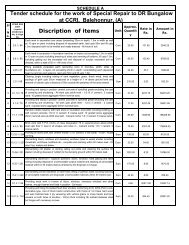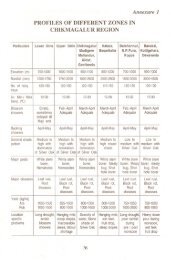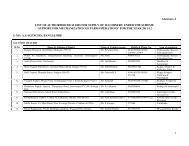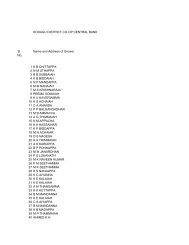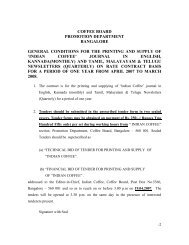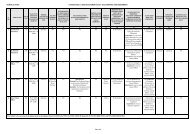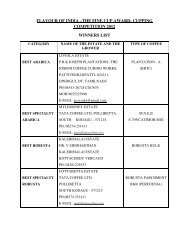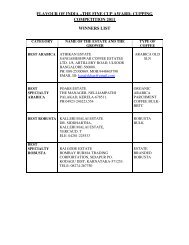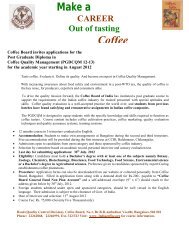COFFEE CULTIVATION GUIDE - Coffee Board of India
COFFEE CULTIVATION GUIDE - Coffee Board of India
COFFEE CULTIVATION GUIDE - Coffee Board of India
You also want an ePaper? Increase the reach of your titles
YUMPU automatically turns print PDFs into web optimized ePapers that Google loves.
16<br />
<strong>COFFEE</strong> WHITE STEM BORER<br />
danger <strong>of</strong> again WSB attacking such cut stems and also such cut stems may dry up<br />
and die.<br />
During these months shade regulation or timber extraction is not a good practice. The<br />
centring <strong>of</strong> the plants should not be taken up during this period. If the plant stems are<br />
smoothened during September months, such stems need to be further smoothened and<br />
while smoothening care should be taken to see that green part <strong>of</strong> the stems are not<br />
damaged. The smoothened stems are then given 10% lime wash (10 kg spray lime +<br />
100ml Fevicol DDL in 100 litres <strong>of</strong> water).<br />
In order to know the untimely emergence <strong>of</strong> beetles, small number <strong>of</strong><br />
pheromone traps can be installed in the field in strategic places. WSB pheromone<br />
traps (25 traps per hectare) have to be installed in highly infested areas.<br />
7. Compost preparation<br />
Composting is a process wherein larger particles <strong>of</strong> biodegradable materials are<br />
broken down into smaller ones by the action <strong>of</strong> soil micro and macro organisms.In<br />
c<strong>of</strong>fee estates lot <strong>of</strong> c<strong>of</strong>fee and shade tree leaf litter, plant prunings, weeded materials,<br />
other green plants, c<strong>of</strong>fee pulp, c<strong>of</strong>fee skin, cherry or parchment husks and other biodegradable<br />
waste materials are available. These materials have good plant nutrient<br />
values and there is a large potential for exploitation <strong>of</strong> the manurial values <strong>of</strong> these<br />
materials. They form good source for the preparation <strong>of</strong> compost in the estates. These<br />
materials can be mixed with coir pith, cow dung and other domestic wastes for<br />
increasing the manurial value <strong>of</strong> the compost. However, the quantity <strong>of</strong> compost<br />
prepared in the estates depends on the quantity <strong>of</strong> the raw materials available on site.<br />
The c<strong>of</strong>fee effluent obtained during the course <strong>of</strong> pulping and washing can be used to<br />
prepare the compost especially for moistening the compost heaps. The c<strong>of</strong>fee skin<br />
obtained during the pulping <strong>of</strong> c<strong>of</strong>fee be mixed with farm yard manure and other<br />
domestic wastes and can be converted into good vermin compost using different<br />
strains <strong>of</strong> earth worms which are available in the Agricultural Universities.<br />
8. Pruning<br />
After the receipt <strong>of</strong> one or two summer showers, c<strong>of</strong>fee plants start producing<br />
new shoots. This is the right time for pruning. Pruning essentially a thinning<br />
process to direct the vigour <strong>of</strong> the plants into those parts which produce crops.<br />
Pruning is to remove the unproductive wood for encouraging the growth <strong>of</strong> new<br />
branches which would become next years cropping wood. Pruning facilitates the<br />
entry <strong>of</strong> adequate sun light and air to all parts <strong>of</strong> the bushes thereby reducing the<br />
16



